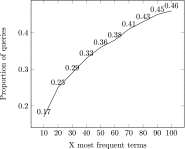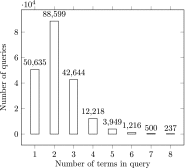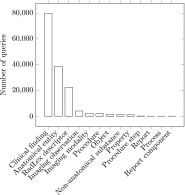Analyzing Medical Image Search Behavior: Semantics and Prediction of Query Results
- PMID: 25810317
- PMCID: PMC4570894
- DOI: 10.1007/s10278-015-9792-6
Analyzing Medical Image Search Behavior: Semantics and Prediction of Query Results
Abstract
Log files of information retrieval systems that record user behavior have been used to improve the outcomes of retrieval systems, understand user behavior, and predict events. In this article, a log file of the ARRS GoldMiner search engine containing 222,005 consecutive queries is analyzed. Time stamps are available for each query, as well as masked IP addresses, which enables to identify queries from the same person. This article describes the ways in which physicians (or Internet searchers interested in medical images) search and proposes potential improvements by suggesting query modifications. For example, many queries contain only few terms and therefore are not specific; others contain spelling mistakes or non-medical terms that likely lead to poor or empty results. One of the goals of this report is to predict the number of results a query will have since such a model allows search engines to automatically propose query modifications in order to avoid result lists that are empty or too large. This prediction is made based on characteristics of the query terms themselves. Prediction of empty results has an accuracy above 88%, and thus can be used to automatically modify the query to avoid empty result sets for a user. The semantic analysis and data of reformulations done by users in the past can aid the development of better search systems, particularly to improve results for novice users. Therefore, this paper gives important ideas to better understand how people search and how to use this knowledge to improve the performance of specialized medical search engines.
Keywords: Human-computer interaction; Image retrieval; Information storage and retrieval; Log file analysis; Machine learning; Medical image search; Statistic analysis.
Figures
Similar articles
-
Comparing image search behaviour in the ARRS GoldMiner search engine and a clinical PACS/RIS.J Biomed Inform. 2015 Aug;56:57-64. doi: 10.1016/j.jbi.2015.04.013. Epub 2015 May 19. J Biomed Inform. 2015. PMID: 26002820
-
Semantic-Enhanced Query Expansion System for Retrieving Medical Image Notes.J Med Syst. 2018 Apr 25;42(6):105. doi: 10.1007/s10916-018-0954-1. J Med Syst. 2018. PMID: 29696548
-
Assisting consumer health information retrieval with query recommendations.J Am Med Inform Assoc. 2006 Jan-Feb;13(1):80-90. doi: 10.1197/jamia.M1820. Epub 2005 Oct 12. J Am Med Inform Assoc. 2006. PMID: 16221944 Free PMC article. Clinical Trial.
-
A review of content-based image retrieval systems in medical applications-clinical benefits and future directions.Int J Med Inform. 2004 Feb;73(1):1-23. doi: 10.1016/j.ijmedinf.2003.11.024. Int J Med Inform. 2004. PMID: 15036075 Review.
-
LinkHub: a Semantic Web system that facilitates cross-database queries and information retrieval in proteomics.BMC Bioinformatics. 2007 May 9;8 Suppl 3(Suppl 3):S5. doi: 10.1186/1471-2105-8-S3-S5. BMC Bioinformatics. 2007. PMID: 17493288 Free PMC article. Review.
References
-
- High-level Expert Group on Scientific Data. Riding the wave: How Europe can gain from the rising tide of scientific data. Submission to the European Commission, available online at http://cordis.europa.eu/fp7/ict/e-infrastructure/docs/hlg-sdi-report.pdf, 2010
-
- Markonis D, Baroz F, de Castaneda RL R, Boyer C, Müller H. User tests for assessing a medical image retrieval system: a pilot study. Stud Health Technol Inf. 2013;192:224–228. - PubMed
Publication types
MeSH terms
LinkOut - more resources
Full Text Sources
Other Literature Sources
Miscellaneous




